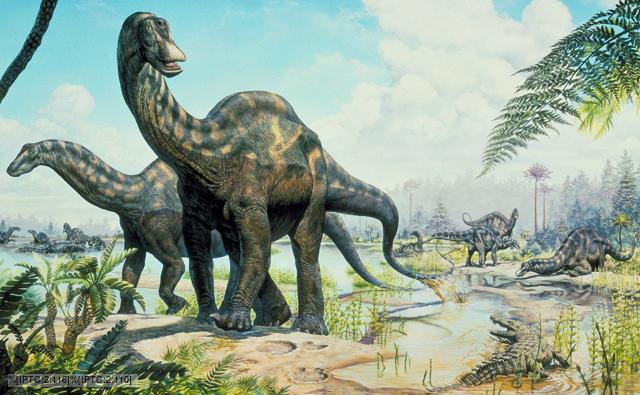
Sauropodomorph dinosaurs
Sauropods are among the most famous and recognisable dinosaurs: long-necked, long-tailed giants that include Diplodocus and Brachiosaurus. Early sauropods were bipedal and quite small compared to their later descendants which became the heaviest and longest dinosaurs. It requires a four-legged stance to get to truly giant size, as you need to spread your weight. Like elephants today, the largest sauropods could only move at a walk as their leg bones couldn't withstand the impact of trotting or galloping gaits. However, just because they were restricted to walking didn't mean they couldn't put on a turn of speed: their top walking speed has been estimated at between 20 and 35 km/h.
Scientific name: Sauropodomorpha
Rank: Suborder
Sauropodomorpha (pron.: /sɔːˌrɒpɵdəˈmɔrfə/ saw-ROP-ə-də-MOR-fə; from Greek, meaning "lizard-footed forms") is an extinct clade of long-necked, herbivorous, saurischian dinosaurs that includes the sauropods and their ancestral relatives. Sauropods generally grew to very large sizes, had long necks and tails, were quadrupedal, and became the largest animals to ever walk the Earth. The "prosauropods", which preceded the sauropods, were smaller and were often able to walk on two legs. The sauropodomorphs were the dominant terrestrial herbivores throughout much of the Mesozoic Era, from their origins in the mid-Triassic until their decline and extinction at the end of the Cretaceous.
Rank: Suborder
Sauropodomorpha (pron.: /sɔːˌrɒpɵdəˈmɔrfə/ saw-ROP-ə-də-MOR-fə; from Greek, meaning "lizard-footed forms") is an extinct clade of long-necked, herbivorous, saurischian dinosaurs that includes the sauropods and their ancestral relatives. Sauropods generally grew to very large sizes, had long necks and tails, were quadrupedal, and became the largest animals to ever walk the Earth. The "prosauropods", which preceded the sauropods, were smaller and were often able to walk on two legs. The sauropodomorphs were the dominant terrestrial herbivores throughout much of the Mesozoic Era, from their origins in the mid-Triassic until their decline and extinction at the end of the Cretaceous.